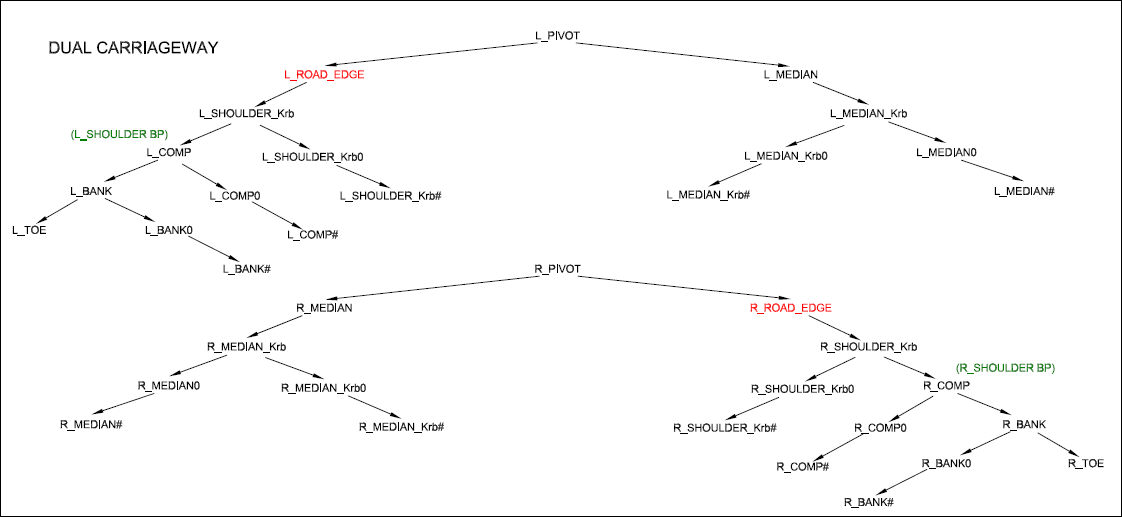
The road strings are ordered according to a specific hierarchy. The master string (M_STRING) contains the coordinated Horizontal Alignment.

The L_PIVOT string contains the vertical alignment string for a single carriageway.

The L_PIVOT string contains the vertical alignment string along the left pivot for the left carriageway. The R_PIVOT string contains the vertical alignment string along the right pivot for the right carriageway.
The string names are used in the Display Settings or plotting routines. The string names, as per the above diagrams, are used, except for the following where alias names are used to make it easier for the user.
|
Alias Name
|
Description |
|
CENTRE LINE |
Alias name for L_PIVOT or MASTER string for dual CW roads. |
|
ROAD_EDGE |
Alias name for SHOULDER (PLC 100 and -100). |
|
SHOULDER_BP |
Alias name for L_COMP of R_COMP (last compulsary). |
|
L_SHOULDER_Krb |
The back of kerb string on the left shoulder. |
|
L_SHOULDER_Krb# |
These strings define the other kerb points between the road edge and back of kerb string. |
|
L_MEDIAN_Krb |
The back of kerb string on the left median. |
|
L_MEDIAN_Krb# |
These strings define the other kerb points between the median edge and back of kerb string. |
|
L_COMP |
The last compulsory string – shoulder break point. |
|
L_COMP_# |
The other compulsory points from the back of kerb string to the L_COMP string. |
|
L_BANK |
The top of bank point (PLC 98). |
|
L_BANK_# |
These strings define the other cut/fill points created by the templates (drains or berms). |
|
L_TOE |
The toe string. |
Islands are add-on strings. All add-on strings have a $$ prefix. Consider an intersecting road island string name $$ISLAND_n_p where:
n is the island number. There might be various islands on an intersecting road.
p is the island position. It can either be ‘s’, which indicates that this island is at the start of the road; or ‘e’, which indicates that this island is at the end of the road.
Consider a main road island name (islands on the main road of roundabouts) of $$MISLAND_n_i_j_p where:
n is the number of the main road island. Tthere might be various main road islands.
i is the road number if the first intersecting road that forms the roundabout
j is the number if the second intersecting road that forms the roundabout
p is 1 if we connect to the start of the road specified in I above else 0
Roundabout circular strings are part of the intersecting roads, so each intersecting road that makes up a roundabout owns half of the roundabout circular island portion. Consider roundabout circular strings RB_s_r_p_k where:
s can be either Crown, Centre or CP.
r is the number of the intersecting road.
p is 1 if we connect to the start of the road specified in I above else 0.
k is kerb postfix, as per all other kerb strings.